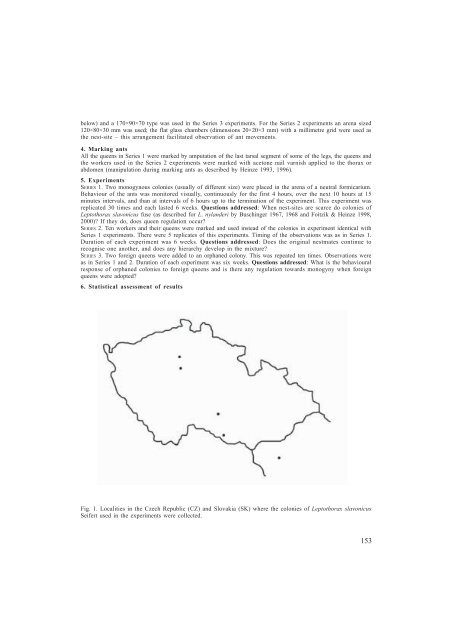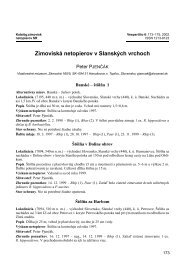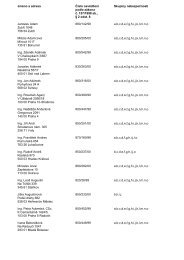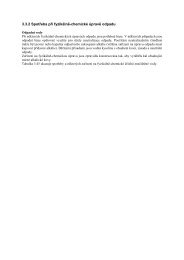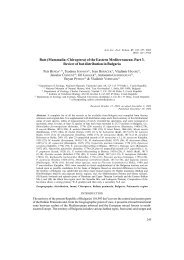elow) and a 170×90×70 type was used <strong>in</strong> <strong>the</strong> Series 3 experiments. For <strong>the</strong> Series 2 experiments an arena sized120×80×30 mm was used; <strong>the</strong> flat glass chambers (dimensions 20×20×3 mm) with a millimetre grid were used as<strong>the</strong> nest-site – this arrangement facilitated observation of ant movements.4. Mark<strong>in</strong>g antsAll <strong>the</strong> queens <strong>in</strong> Series 1 were marked by amputation of <strong>the</strong> last tarsal segment of some of <strong>the</strong> legs, <strong>the</strong> queens and<strong>the</strong> workers used <strong>in</strong> <strong>the</strong> Series 2 experiments were marked with acetone nail varnish applied to <strong>the</strong> thorax orabdomen (manipulation dur<strong>in</strong>g mark<strong>in</strong>g ants as described by He<strong>in</strong>ze 1993, 1996).5. ExperimentsSERIES 1. Two monogynous colonies (usually of different size) were placed <strong>in</strong> <strong>the</strong> arena of a neutral formicarium.Behaviour of <strong>the</strong> ants was monitored visually, cont<strong>in</strong>uously for <strong>the</strong> first 4 hours, over <strong>the</strong> next 10 hours at 15m<strong>in</strong>utes <strong>in</strong>tervals, and than at <strong>in</strong>tervals of 6 hours up to <strong>the</strong> term<strong>in</strong>ation of <strong>the</strong> experiment. This experiment wasreplicated 30 times and each lasted 6 weeks. Questions addressed: When nest-sites are scarce do colonies ofLeptothorax slavonicus fuse (as described for L. nylanderi by Busch<strong>in</strong>ger 1967, 1968 and Foitzik & He<strong>in</strong>ze 1998,2000)? If <strong>the</strong>y do, does queen regulation occur?SERIES 2. Ten workers and <strong>the</strong>ir queens were marked and used <strong>in</strong>stead of <strong>the</strong> colonies <strong>in</strong> experiment identical withSeries 1 experiments. There were 5 replicates of this experiments. Tim<strong>in</strong>g of <strong>the</strong> observations was as <strong>in</strong> Series 1.Duration of each experiment was 6 weeks. Questions addressed: Does <strong>the</strong> orig<strong>in</strong>al nestmates cont<strong>in</strong>ue torecognise one ano<strong>the</strong>r, and does any hierarchy develop <strong>in</strong> <strong>the</strong> mixture?SERIES 3. Two foreign queens were added to an orphaned colony. This was repeated ten times. Observations wereas <strong>in</strong> Series 1 and 2. Duration of each experiment was six weeks. Questions addressed: What is <strong>the</strong> behaviouralresponse of orphaned colonies to foreign queens and is <strong>the</strong>re any regulation towards monogyny when foreignqueens were adopted?6. Statistical assessment of resultsFig. 1. Localities <strong>in</strong> <strong>the</strong> <strong>Czech</strong> <strong>Republic</strong> (CZ) and Slovakia (SK) where <strong>the</strong> colonies of Leptothorax slavonicusSeifert used <strong>in</strong> <strong>the</strong> experiments were collected.153
Tab. 1. Summary of experimental results. Explanations: N – number of experiments, NRM – number of regulationsto monogyny (= elim<strong>in</strong>ation of supernumerary queens), NF – number of fusions of two monogyous colonies,N2M – number of orig<strong>in</strong>ations of two monogynous colonies, N0 – number of experiments result<strong>in</strong>g <strong>in</strong> orphancyof <strong>the</strong> colony, NAQ – number of adoptions of an alien queen; * – adoption before orphancy, ** – adoption of aw<strong>in</strong>n<strong>in</strong>g by workers from <strong>the</strong> colony of <strong>the</strong> elim<strong>in</strong>ated queen after <strong>the</strong> fusiondesign N = 100% NRM NF N2M NO NAQseries 1 30 24 24 6 1* 24**series 2 5 0 0 5 0 0series 3 10 6 0 0 4 6Fisher exact test from Statistica 93 was used <strong>in</strong> <strong>the</strong> statistical evaluation of <strong>the</strong> choice of a queen.RESULTS1. Monogyny of Leptothorax slavonicus <strong>in</strong> <strong>the</strong> fieldAll of <strong>the</strong> 238 colonies exam<strong>in</strong>ed (100%) had only one queen.2. Experiments (Tab. 1, Fig. 2)SERIES 1. The mix<strong>in</strong>g of two monogynous colonies (30 experiments) resulted <strong>in</strong> <strong>the</strong> colonies fus<strong>in</strong>gto form one colony, and <strong>the</strong> workers reduc<strong>in</strong>g <strong>the</strong> number of queens to one <strong>in</strong> 24 cases (monogynouscolonies formed <strong>in</strong> all cases except one, <strong>in</strong> which <strong>the</strong> accepted queen died before <strong>the</strong> term<strong>in</strong>ationof <strong>the</strong> experiment, and an orphaned colony resulted). The colonies separated and formed twomonogynous colonies, each <strong>in</strong> a different part of <strong>the</strong> formicarium <strong>in</strong> 6 cases. A digynous colonywas never formed.SERIES 2. The mix<strong>in</strong>g of two marked groups of ants (5 experiments) resulted <strong>in</strong> <strong>the</strong> ants of <strong>the</strong>different colonies liv<strong>in</strong>g <strong>in</strong> one formicarium, but as two autonomous and dist<strong>in</strong>ct fractions. No caseof fusion was observed.SERIES 3. When two foreign queens were offered to an orphaned colony (10 experiments) onequeen was adopted, <strong>the</strong> o<strong>the</strong>r elim<strong>in</strong>ated <strong>in</strong> 6 cases, and both queens elim<strong>in</strong>ated, i. e. <strong>the</strong> coloniesrema<strong>in</strong>ed without queen, <strong>in</strong> 4 cases.3. Behaviour of ants dur<strong>in</strong>g experiments3. 1. Experimental Series 1The ants first explored <strong>the</strong> arena and nest-site, which was accompanied by aggressive <strong>in</strong>teractionsbetween <strong>the</strong> workers and attacks on both queens, <strong>the</strong>n formed a cluster around each queen, andei<strong>the</strong>r reta<strong>in</strong>ed this separation up to <strong>the</strong> term<strong>in</strong>ation of <strong>the</strong> experiment, or <strong>the</strong> clusters <strong>in</strong>habited <strong>the</strong>nest-site, formed a fused colony, and regulated <strong>the</strong> number of queens to one. Six successivebehavioural phases (unless stated o<strong>the</strong>rwise) were identified <strong>in</strong> nearly all <strong>the</strong> experiments : a-b-cd-e-f,or a-b-c-d-g-h.(a) Exploration. Dur<strong>in</strong>g this phase <strong>the</strong> ants became acqua<strong>in</strong>ted with <strong>the</strong> new situation, arena andstrangers. This was associated with <strong>in</strong>creased mobility with exploratory behaviour prevail<strong>in</strong>g overo<strong>the</strong>r activities. Ritualised attacks <strong>in</strong> which <strong>the</strong> mandibles were opened wide aga<strong>in</strong>st strangers,but <strong>the</strong>re was no body contact, were common. Groom<strong>in</strong>g of <strong>the</strong> queens by workers lasted until oneof <strong>the</strong> queens was elim<strong>in</strong>ated. Duration of this phase was about 15 m<strong>in</strong>utes.(b) Aggregation of workers around <strong>the</strong> alien queen dur<strong>in</strong>g which <strong>the</strong> workers seized <strong>the</strong> legs,antennae, head of <strong>the</strong> queen and dragged it across <strong>the</strong> arena or transported it by hold<strong>in</strong>g it by itspetiole and attacked it with <strong>the</strong>ir mandibles. The queens characteristically rema<strong>in</strong>ed passive andrigid dur<strong>in</strong>g transportation. At <strong>the</strong> same time <strong>the</strong> workers explored <strong>the</strong> nest-site and transported154
- Page 2:
Acta Soc. Zool. Bohem. 66: 81-84, 2
- Page 5 and 6:
REFERENCESBERAN L. & HORSÁK M. 199
- Page 7:
Tab. 1. Nematodes studied with the
- Page 10:
Tab. 2. The dimensions (mm) of thir
- Page 14 and 15:
Family Acuariidae Railliet, Henry e
- Page 16 and 17:
Fig. 7. Cosmocephalus obvelatus (Cr
- Page 18 and 19:
A c k n o w l e d g e m e n t sThe
- Page 20 and 21:
Acta Soc. Zool. Bohem. 66: 99-119,
- Page 22 and 23:
Figs 1-10. Harpalus (Harpalus) atra
- Page 24 and 25: Figs 11-19. Harpalus (Harpalus) cis
- Page 26 and 27: Figs 20-27. Harpalus (Harpalus) lut
- Page 28 and 29: Figs 28-35. Harpalus (Harpalus) pic
- Page 30 and 31: Figs 36-44. Harpalus (Harpalus) sax
- Page 32 and 33: Figs 45-53. Harpalus (Harpalus) ser
- Page 34 and 35: Figs 54-61. Harpalus (Harpalus) sol
- Page 36 and 37: Figs 62-70. Harpalus (Harpalus) xan
- Page 38 and 39: Based on the study of our larval ma
- Page 40 and 41: EMDEN F. I. van 1942: A key to the
- Page 42 and 43: Acta Soc. Zool. Bohem. 66: 121-140,
- Page 44 and 45: and D. papillifera (Fuhrmann, 1908)
- Page 46 and 47: about 1 mm) with only a few eggs in
- Page 48 and 49: The number of catfish examined each
- Page 50 and 51: number (3.65) of trematodes with ma
- Page 52 and 53: cestode was distinctly associated w
- Page 54 and 55: from individual months. Tab. 2 show
- Page 56 and 57: number (5.57) of males occurred in
- Page 58 and 59: intermediate host, copepod, catfish
- Page 60 and 61: CHUBB J. C. 1982: Seasonal occurren
- Page 62 and 63: Acta Soc. Zool. Bohem. 66: 141-150,
- Page 64 and 65: efore distal angle of discoidal tri
- Page 66 and 67: cells between them and IR2 or MA”
- Page 68 and 69: character is less pronounced in Oli
- Page 70 and 71: REFERENCESBACHMAYER F. 1952: Fossil
- Page 72 and 73: Acta Soc. Zool. Bohem. 66: 151-160,
- Page 76 and 77: the brood, first into heaps near th
- Page 78 and 79: trophallaxis until the termination
- Page 80 and 81: 4. The queen that was accepted was


